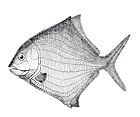| Tanyrhinichthys Temporal range: Kasimovian ~307–303.7 Ma PreꞒ Ꞓ O S D C P T J K Pg N ↓ | |
|---|---|
| Scientific classification | |
| Domain: | Eukaryota |
| Kingdom: | Animalia |
| Phylum: | Chordata |
| Class: | Actinopterygii |
| Genus: | †Tanyrhinichthys Gottfried, 1987 |
| Type species | |
| †Tanyrhinichthys mcallisteri Gottfried, 1987 | |
Tanyrhinichthys is an extinct genus of prehistoric ray-finned fish with a lengthened rostrum that lived during the Kasimovian (Missourian) age (Upper Pennsylvanian, Upper Carboniferous) in what is now New Mexico, United States. Fossils were recovered from Tinajas Member of the Atrasado Formation (Kinney Brick Quarry).
Ecology and evolution
Tanyrhinichthys had an elongated rostrum equipped with sensory canals, which allowed it to find prey organisms hidden in the substrate, similar to modern sturgeons. It is one of the first actinopterygians to independently evolve an elongate rostrum during the Paleozoic Era, along with Tegeolepis and Phanerorhynchus.
See also
References
- ^ Stack, Jack; Hodnett, John-Paul; Lucas, Spencer G.; Sallan, Lauren (2021). "Tanyrhinichthys mcallisteri, a long-rostrumed Pennsylvanian ray-finned fish (Actinopterygii) and the simultaneous appearance of novel ecomorphologies in Late Palaeozoic fishes". Zoological Journal of the Linnean Society. 191 (2): 347–374. doi:10.1093/zoolinnean/zlaa044.
This article about a prehistoric ray-finned fish is a stub. You can help Misplaced Pages by expanding it. |







